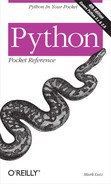This section describes the rules for syntax and variable names.
Here are the general rules for writing Python programs:
- Control flow
Statements execute one after another, unless control-flow statements are used (
if,while,for,raise, calls, etc.).- Blocks
A block is delimited by indenting all of its statements by the same amount, with spaces or tabs. A tab counts for enough spaces to move the column to a multiple of 8. Blocks can appear on the same line as a statement header if they are simple statements.
- Statements
A statement ends at the end of a line, but can continue over multiple lines if a physical line ends with a
, an unclosed(),[], or{}pair, or an unclosed, triple-quoted string. Multiple simple statements can appear on a line if they are separated with a semicolon (;).- Comments
Comments start with a
#(not in a string constant) and span to the end of the line.- Documentation strings
If a function, module file, or class begins with a string literal, it is stored in the object’s
__doc__attribute. See thehelp()function, and thepydocmodule and script in the Python Library Reference for automated extraction and display tools.- Whitespace
Generally significant only to the left of code, where indentation is used to group blocks. Blank lines and spaces are otherwise ignored except as token separators and within string constants.
This section contains the rules for user-defined names (i.e., variables) in programs.
- Structure
User-defined names start with a letter or underscore (
_), followed by any number of letters, digits, or underscores.- Reserved words
User-defined names cannot be the same as any Python reserved word listed in Table 1-12.[3]
- Case sensitivity
User-defined names and reserved words are always case-sensitive: SPAM, spam, and Spam are different names.
- Unused tokens
Python does not use the characters
$and?in its syntax, though they can appear in string constants and comments, and$is special in string template substitution.- Creation
User-defined names are created by assignment but must exist when referenced (e.g., counters must be explicitly initialized to zero). See the section Namespace and Scope Rules.
Table 1-12. Python 3.0 reserved words
|
|
|
|
|
|
|
|
|
|
|
|
|
|
|
|
|
|
|
|
|
|
|
|
|
|
|
|
| |
|
|
|
|
Note
In Python 2.6, print and
exec are both reserved words,
as they take the form of statements, not built-in functions. Also
in Python 2.6, nonlocal,
True, and False are not reserved words; the first
of these is unavailable, and the latter two are simply built-in
names. with and as are reserved in both 2.6 and 3.0, but
not in earlier 2.X releases unless context managers are explicitly
enabled. yield is reserved as
of 2.3; it morphed from statement to expression later but is still
a reserved word.
Names that begin and end with two underscores (for example,
__init__) have a special meaning to the interpreter but are not reserved words.Names beginning with one underscore (e.g.,
_X) and assigned at the top level of a module are not copied out byfrom...*imports (see also the__all__module export names list, mentioned in the sections The from Statement and Pseudoprivate Attributes). In other contexts, this is an informal convention for internal names.Names beginning but not ending with two underscores (e.g.,
__X) within aclassstatement are prefixed with the enclosing class’s name (see Pseudoprivate Attributes).The name that is just a single underscore (
_) is used in the interactive interpreter (only) to store the result of the last evaluation.Built-in function and exception names (e.g.,
open,SyntaxError) are not reserved words. They live in the last-searched scope and can be reassigned to hide the built-in meaning in the current scope (e.g.,open=myfunction).Class names commonly begin with an uppercase letter (e.g.,
MyClass), and modules with a lowercase letter (e.g.,mymodule).The first (leftmost) argument in a class method function is usually named
self.
[3] In the Jython Java-based implementation, user-defined names can sometimes be the same as reserved words.
